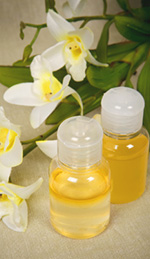 One of the most frequent questions we receive at Essential Oil Exchange is what makes an essential oil suitable for use in aromatherapy. An aromatherapy oil should always be therapeutic-grade, a term that we discuss in detail in “Essential Oils and Aromatherapy: What is Therapeutic Grade?” Basically, a therapeutic-grade aromatherapy oil has been distilled under lower temperatures and pressures than mass-produced commercial-grade oils, in order to create an essential oil with a range and ratio of constituents that are as close to the living plant as possible. Because essential oils represent highly concentrated versions of these constituents, this makes aromatherapeutic-grade oils a power tool in the holistic healthcare practitioner’s toolkit.
One of the most frequent questions we receive at Essential Oil Exchange is what makes an essential oil suitable for use in aromatherapy. An aromatherapy oil should always be therapeutic-grade, a term that we discuss in detail in “Essential Oils and Aromatherapy: What is Therapeutic Grade?” Basically, a therapeutic-grade aromatherapy oil has been distilled under lower temperatures and pressures than mass-produced commercial-grade oils, in order to create an essential oil with a range and ratio of constituents that are as close to the living plant as possible. Because essential oils represent highly concentrated versions of these constituents, this makes aromatherapeutic-grade oils a power tool in the holistic healthcare practitioner’s toolkit.
Although therapeutic-grade oils are often organic, this isn’t a necessary component of the rating: whether they’ve been organically or conventionally grown, essential oils are rated therapeutic-grade if they’ve been grown, harvested, distilled and stored using optimal techniques designed to preserve the greatest range of active constituents. In addition, aromatherapy oils must be free of synthetic additives and cannot be adulterated with other oils not listed on the label—although blends that contain a stated mixture of essential oils may be used by some aromatherapists. For instance, to be therapeutic grade, a lavender essential oil cannot be adulterated with either synthetic lavender oil constituents or lavandin (spike lavender) oil, which produces different therapeutic effects. While this means that therapeutic-grade aromatherapy oils are more expensive, the extra price is worth it since they are being used to produce a desired therapeutic effect.
While not suitable for aromtherapy, non-therapeutic grade essential oils can still be used in detergents, soaps, candles, and personal fragrances. When buying an essential oil, let your intention for its use guide your purchase: do you want to use your essential oil in aromatherapy? As a cleanser or perfume? In soap or candle making? For purposes other than aromatherapy, you can save by buying inexpensive commercial-grade essential oils, including essential oils that have been pre-blended into a carrier oil such as almond or olive oil for ease of use. Although pre-blended oils have a shorter shelf life, they are ideal if you want to get creative in making your own fragrances and bath products.
Make Your Own Herbal Oil Infusions at Home!
With a little time and experimentation, you can also make your own herbal oil infusions by steeping raw plant material into a carrier oil such as olive, jojoba, or almond oil. Although the finished product will not be as concentrated as a steam-distilled essential oil, you will end up with a versatile finished oil that can be used in soap and candle making, fragrances, bath oils, and other homemade products.
Preparation: Pour your chosen carrier oil—olive, jojoba, or almond oils work well—into a large screw-cap glass bottle until it is half full, then pack the bottle with the plant material you want to infuse. Lavender works well in this preparation, but not all aromatic plants do, so make sure to research the plant you want to infuse before trying this recipe. Screw the cap on tight and let the bottle sit in a cool, dark place for at least 3 days, shaking the bottle once every 24 hours. Strain the finished oil through cheesecloth into a dark glass or stainless steel bottle. If the aroma is too weak, try adding a bit more raw plant material and letting it steep an extra day or so before straining the oil. Stored in a cool, dry place, this mixture will last about 6 months—long enough to fulfill all your perfumery and crafting needs!
